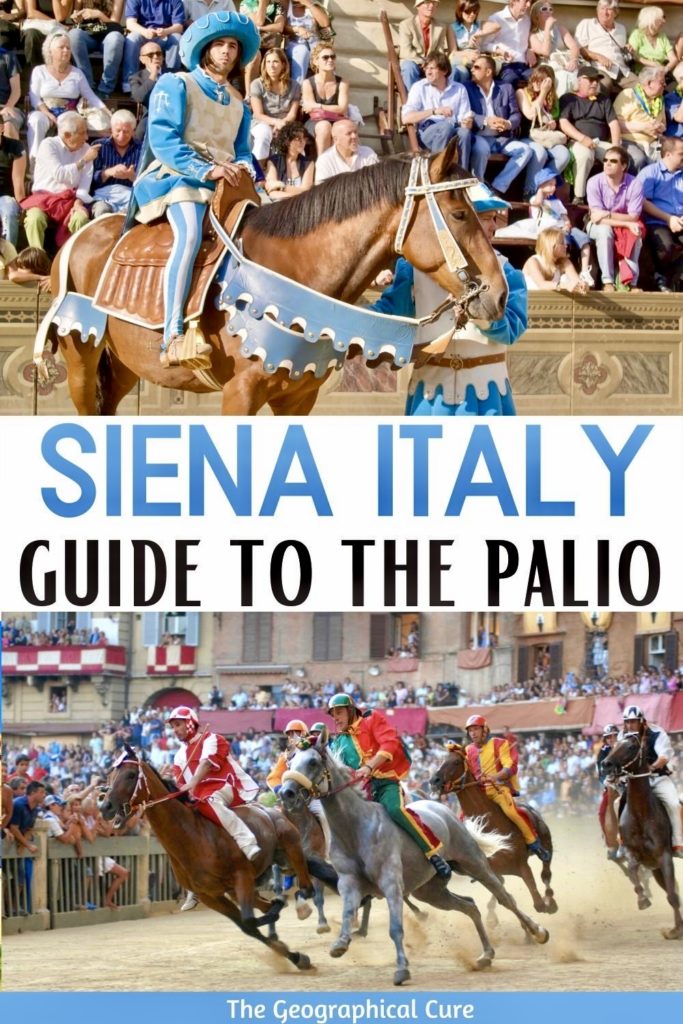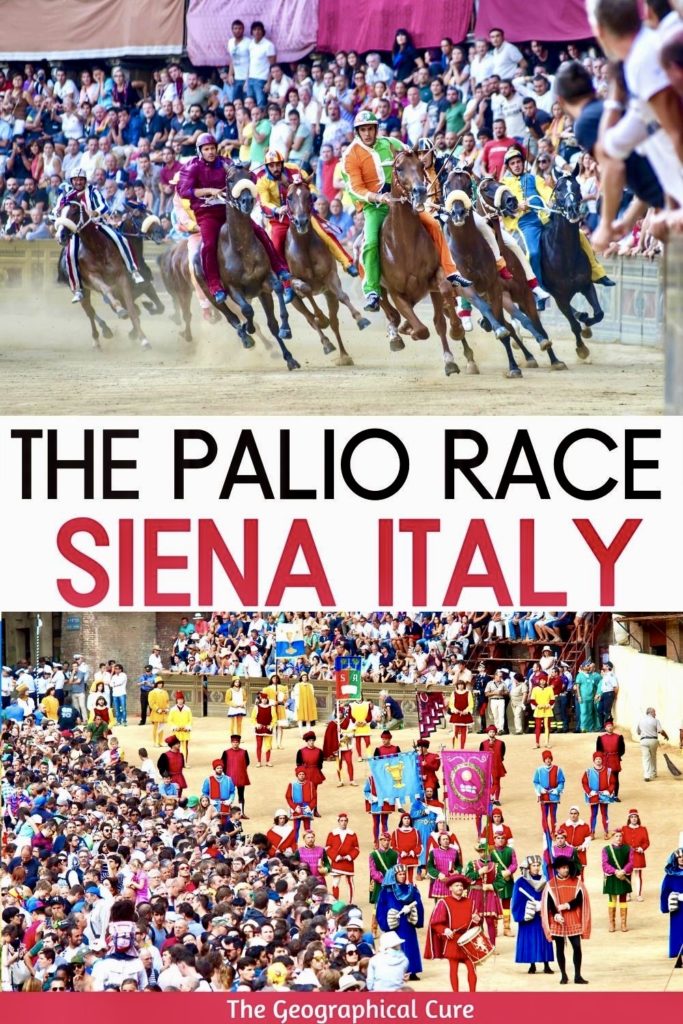Looking for a truly unique and authentic cultural experience in Italy? Consider attending the Palio of Siena.
The Palio is one of the world’s most exciting and theatrical events.It’s a chaotic medieval-style horserace that takes place twice a year in the Piazza del Campo, Siena’s famous central square.
It’s a stirring tableaux that brings the Sienese to tears of joy and despair, despite the race’s macho nature.
The race is organized by Siena’s 17 contrade, which are tightly knit neighborhood communities that compete against each other.
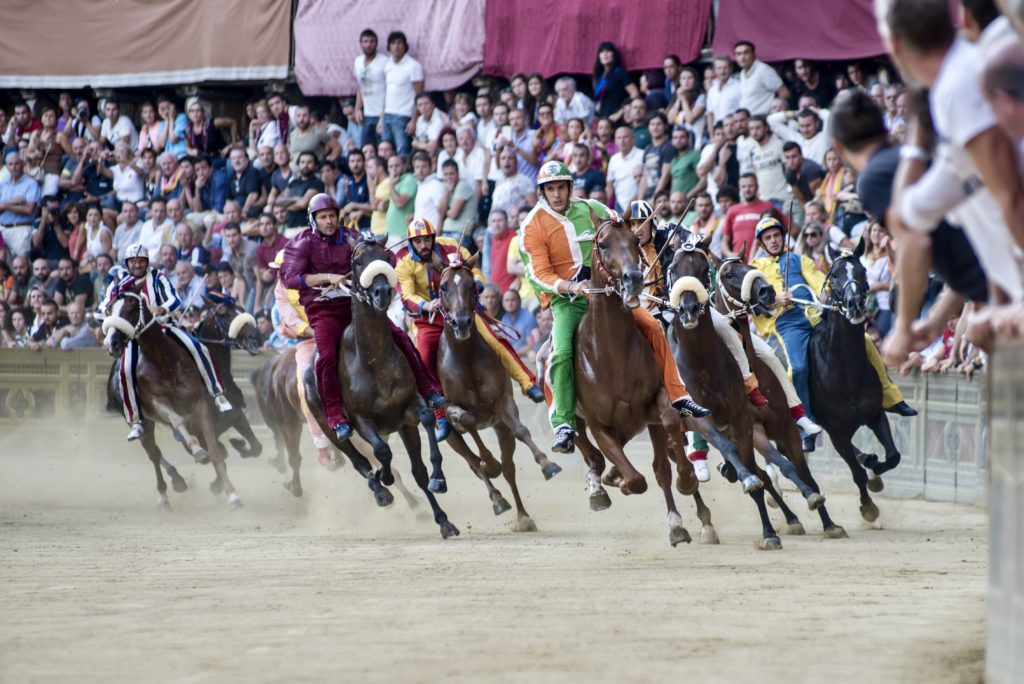
Nothing matters more to the Sienese than winning this race. And this is no exaggeration. They go to enormous lengths to succeed.
When I was in Siena last month, I was lucky enough to have a private tour of one of the contrade of Siena, the Caterpillar contrada, with one of their members Dario.
It was an absolutely fascinating tour. I got the inside scoop on the nature of a contrade and how much the Palio means to them.
In this guide, I tell you everything you need to know about the Palio and the contrade of Siena competitors. You’ll also find tips for attending the race.
Overview Of The Palio
The Palio dates back to the 13th century, and most likely began as a Roman military training exercise. The Palio races are held on July 2 and August 16 each year.
Both horse races are in honor of the Virgin Mary. The July Palio is dedicated to the Madonna di Provengano, who, miraculously, saw the Virgin in the area of the Giraffe Contrada. The August Palio is dedicated to the Feast of the Assumption.
The term “Palio” is Italian for the Latin word Pallium. A pallium is a vertical rectangular piece of cloth. This piece of cloth is the deeply coveted trophy of the horse race. There’s no cash prize.
The Palio is a work of art, always created by an important contemporary artist. The banners they create always feature an image of the virgin.
The Palio is more than just a horse race. It’s the culmination of ongoing rivalry and competition between the contrade. It’s the central point of urban Sienese identify.
The horse race takes place in the main square, Il Compo. It has a semi-circular shape with sharp turns.
To prepare for the Palio, the square is turned into a racetrack. The gray flagstone around the square is covered with a thick layers of dirt brought in by the truckload. As the track is transformed, the excitement builds.
Only 10 horses can race. The horses represent 10 of the 17 contrade of Siena.
Because it’s too crowded to have 17 horses race at one time, only 10 can enter the competition. If a contrada is excluded one year, they are guaranteed to compete the next year.
After the first 7 automatic qualifiers from exclusions, the remaining 3 slots are awarded by lottery, during the last week of May and the first week of July.
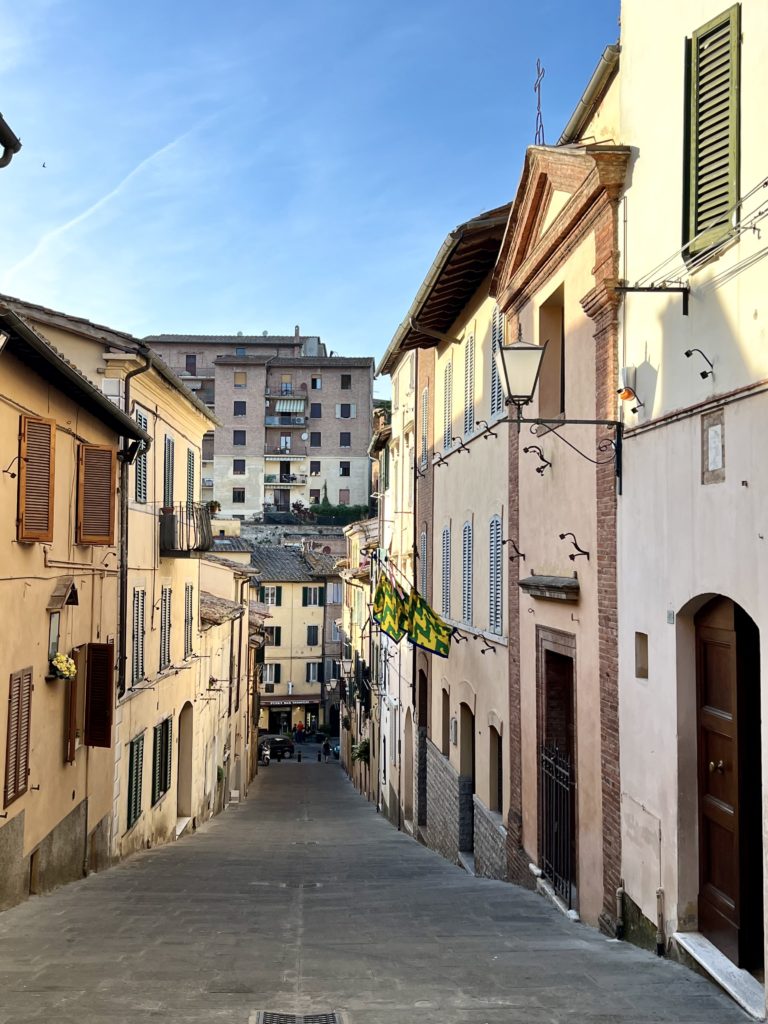
What Is A Contrada?
When Siena was finally conquered by Florence in 1555, after centuries of battles, the republic was defeated and their territorial ambitions blighted.
The city turned internal. They could no longer compete against other cities for supremacy, but they could still compete among themselves.
The contrade were instituted in the 12th and 13th centuries. Initially, the contrade were military companies divided into geographic districts that were hired to defend Siena against Florence.
But that evolved over time and the contrade were modernized after Siena’s defeat. The contrade became social and “family” organizations that are now the very soul of Siena.
To their members, the contrade are everything. They have an almost spiritual sense of community and tribalism.
The contrade all have symbols and colorful flags. The symbols are usually animal names like wolf, dragon, eagle, or porcupine. It’s unknown why these names were chosen, possibly because of some special historical event.
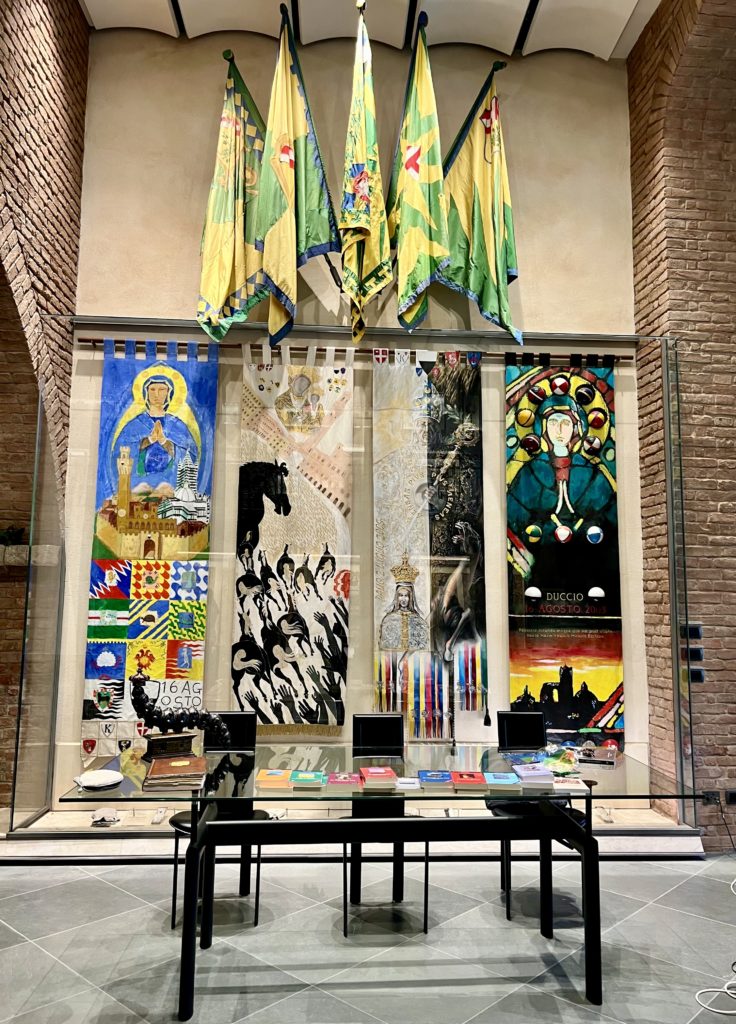
Specifically, the contrade include: Aquila (Eagle), Bruco (Caterpillar), Chiocciola (Snail) Civetta (Owl), Drago (Dragon) Giraffa (Giraffe), Istrice (Porcupine) Leocorno (She-Wolf) Niccihio (Seashell) Oca (Goose), Onda (Wave), Pantera (panther), Selva (Forest) Tartuca (Turtle) Torre (Tower) and Valdimontone (Valley of the Ram).
Each contrada has its own territory within the medieval city walls. They also have a headquarters, museum, chapel, public square, and fountain.
The leader of the contrada is selected by vote. They could be male or female. There’s no discrimination on the basis of sex.
The contrade pride themselves in not being political. They are also classless. All members — contradaioli — are equal, whether rich or poor.
The contrade have their own local government, constitution, and culture — like a mini city-state. All contrade members pay dues to offset the upkeep and expenses of the contrade.
The contrade have 2-3 contrade dinners each week where they eat together en masse family style. Not everyone shows up every time, but it’s usually a large gathering.
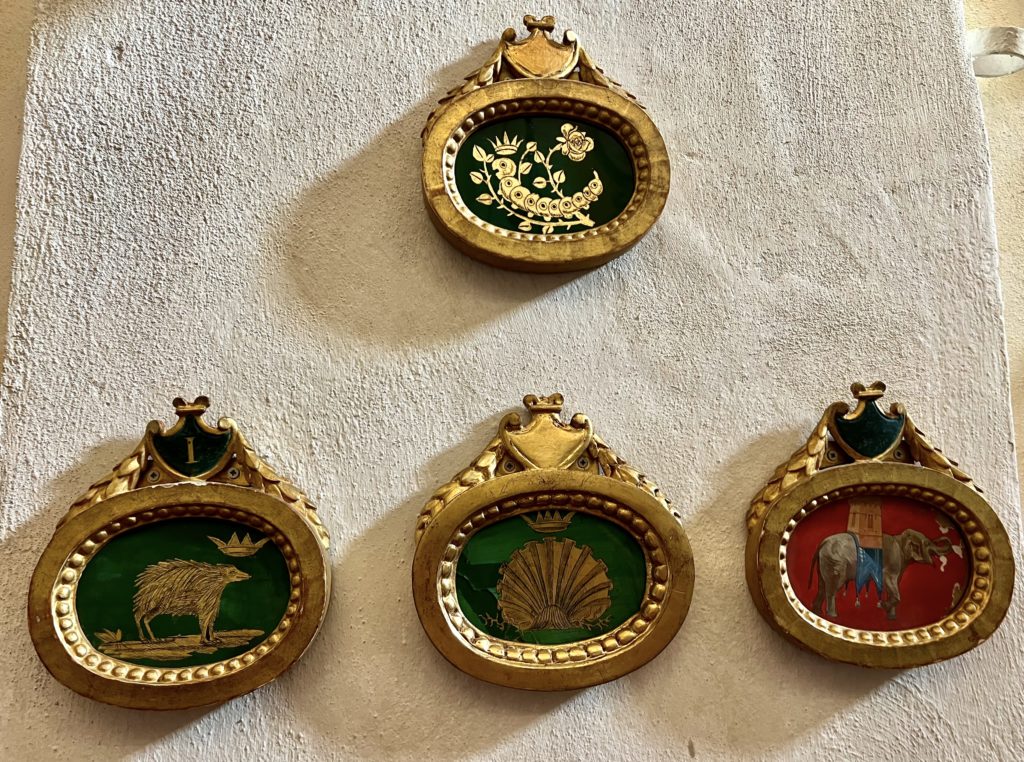
The contrade celebrate the members’ births, marriages, and deaths. When I was there, two flags with pink ribbons flew at the Caterpillar Contrada for two girls that had just been born that day.
Initially, membership in a contrade was determined by which contrade territory you were born in. But, today, that’s an impractical rule since most babies are born in the hospital.
The modern rule is that your contrada is determined by “birth, blood or choice.” The contrade may be exclusive, but they don’t exclude.
You can marry outside your contrada. It’s completely socially acceptable.
“Mixed marriages” are common nowadays, though they weren’t in the past. Children typically take the contrada of one of their parents.
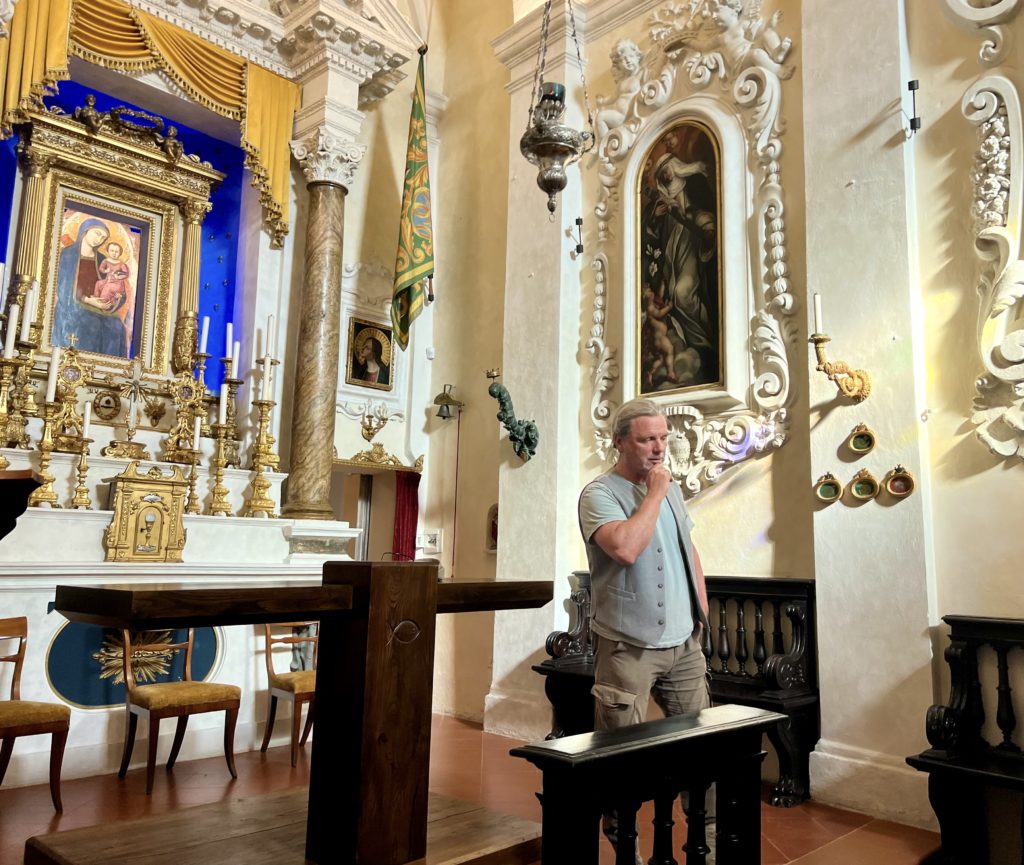
During Palio, a “mixed marriage” couple will part ways for awhile and socialize with their own contrada.
There are four types of contrade relationships — ally, friendship, no relationship, or enemy.
Most contrade have a nemesis contrada that is their avowed enemy. They don’t hate each other per se (until the Palio). But they compete with them in everything all year round.
The origin of the enmities is largely unknown. But they could have arisen from boundary disputes about territory or something that happened in the Palio.
Not all contrade have a reciprocal enmity pair. For example, the Caterpillar Contrada and the Goose Contrada were once fierce rivals. But they signed a peace treaty in 1996.
The contrada will also have one or more allies or “sister” contrada. And sometimes they are entirely indifferent to another contrada, barely recognizing them.
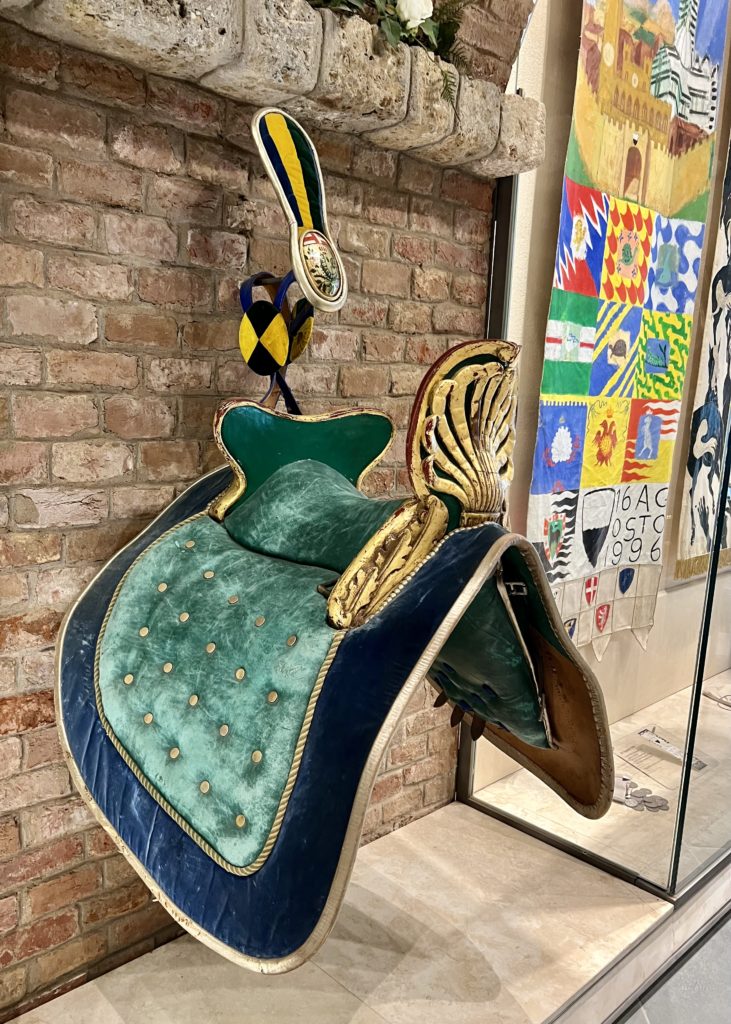
All these rivalries and alliances may shift over time.
The contrade refer to themselves by their animal names in daily conversation.
For example, a person might say that “a caterpillar dating a dragon was seen eating in a goose restaurant.”
For the contrade, the Palio is everything. With this historic event, the Sienese confirm their community, their culture, and history.
The Palio is a win at all costs war. The contrade will do whatever it takes to win a Palio, for the prestige it conveys, including spending huge sums of a contrada’s money.
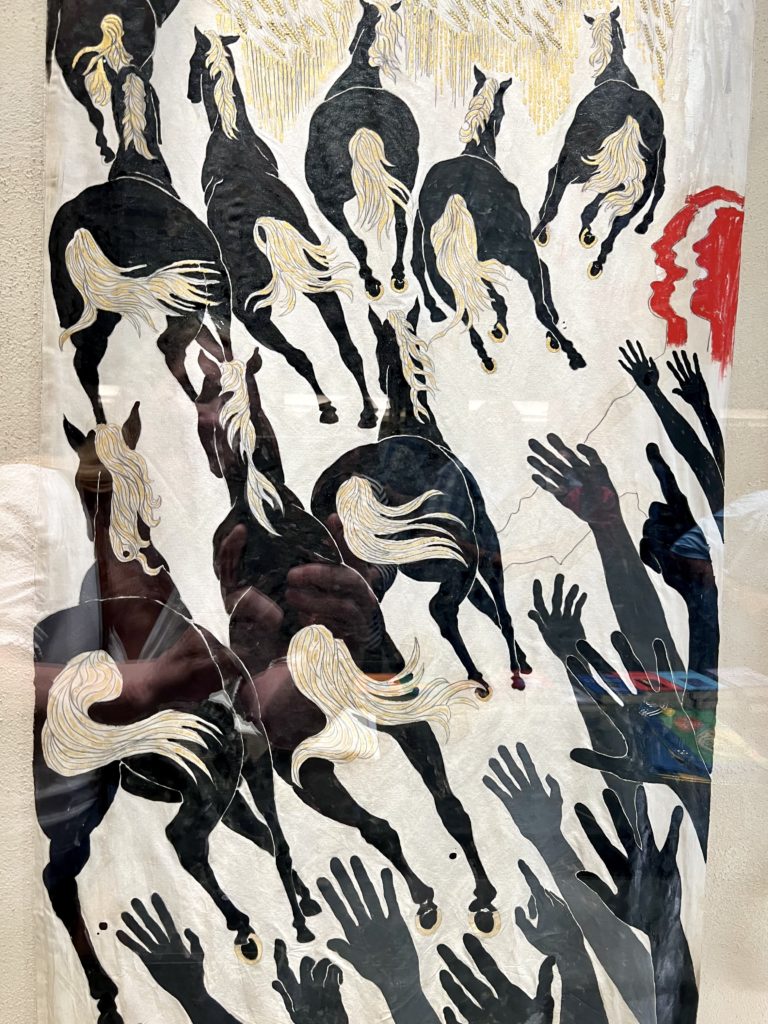
Winning the Palio is the single most important event of a Sienese person. They live and die for the race.
In the weeks leading up to the Palio, there may be icy relations between friends from competing contrade. There may be fisticuffs. But, to prevent serious injury, the unstated rule that everyone follows is that you can only use open hands.
A Palio win is the highlight of a lifetime. If you come in second, you are the official “loser” of the Palio. The losing contrada could be mocked by an enemy contrada.
The Palio Horses
The horses are specifically bred for the Palio. They’re mixed breed Anglo-Arab horses, chosen in part for their ability not to be spooked by the crowds and utter chaos.
Before the Palio, horses are selected and inspected by the contrade. But the strongest and weakest horses are excluded in the interest of “fairness,” leaving only 10 left for the race.
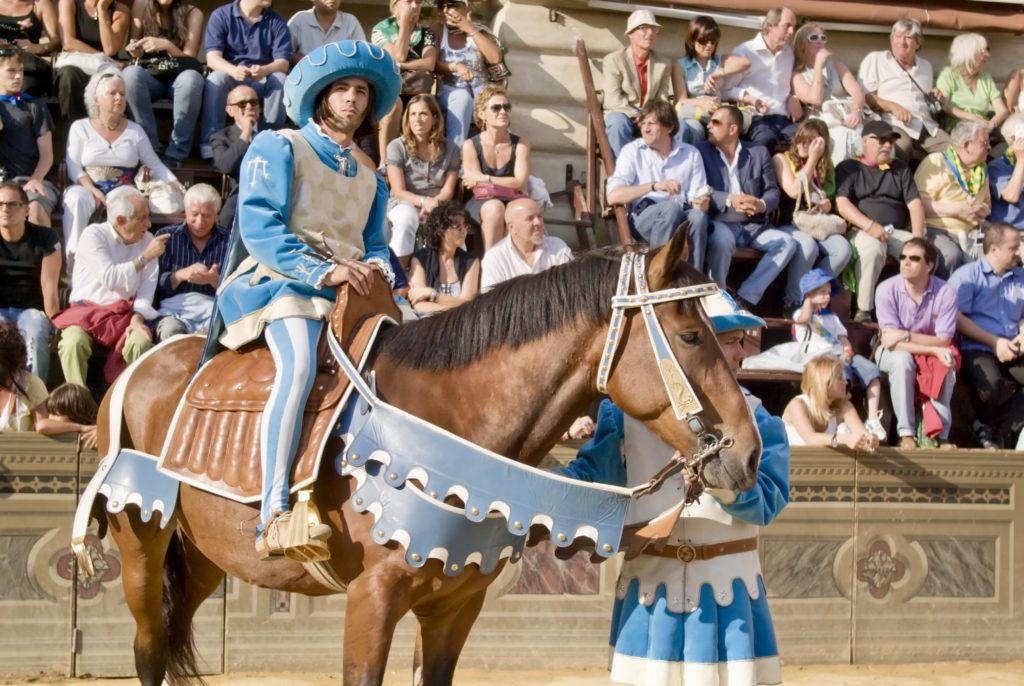
The horses are assigned to the contrade by lottery. This is a fateful day, with hushed audiences as the contrade hope and pray to be assigned a fast horse.
The best case scenario is for your contrada to get a fast horse and your enemy contrada to get a bad horse.
If a contrada is assigned a fast horse, they will spare no expense to win the Palio. If a contrada’s rival gets the speedy horse, the contrada may try to secure the best jockey to keep the enemy from winning.
Once selected, the contrade “bless” the horses in the contrade chapels and spray them with holy water. If the horse poops or misbehaves in the chapel, it’s considered a good omen.
The contrade install their horses in five star accommodations. They also protect the horses from any attempt to poison or otherwise sabotage their performance. Yes, horses have actually been drugged in the past.
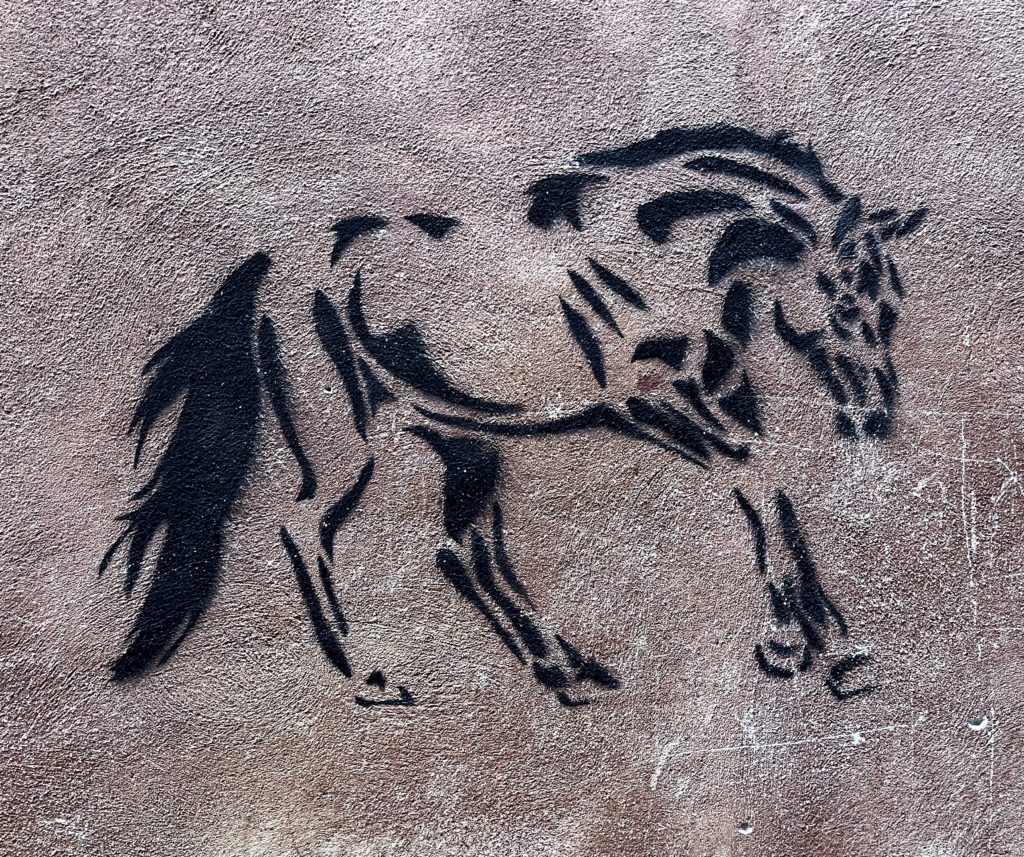
Pre-Race Machiavellian Machinations
Then, the next phase of the Palio begins. Once a contrada is assigned a horse, the contrade hire their own jockeys. The jockeys are pros and most come from Sardinia.
The jockeys are true mercenaries. They command high prices, which vary depending on the the jockeys’ experience and track record.
Back in 2003, the Caterpillar Contrada paid 1.5 million euros to hire their preferred jockey. Jockeys are so expensive that contrade are often left bankrupt after winning the Palio.
There are really no rules for the race. Jockeys will often negotiate secret deals.
They will bribe one another, out in the open, before the contest begins. It’s not really considered “bribery,” but more of a “strategy.”
Though they are hired by a contrada and wear its colors, the jockeys may be double agents, as though they’re in a James Bond movie. Betrayal is common and guile is prized.
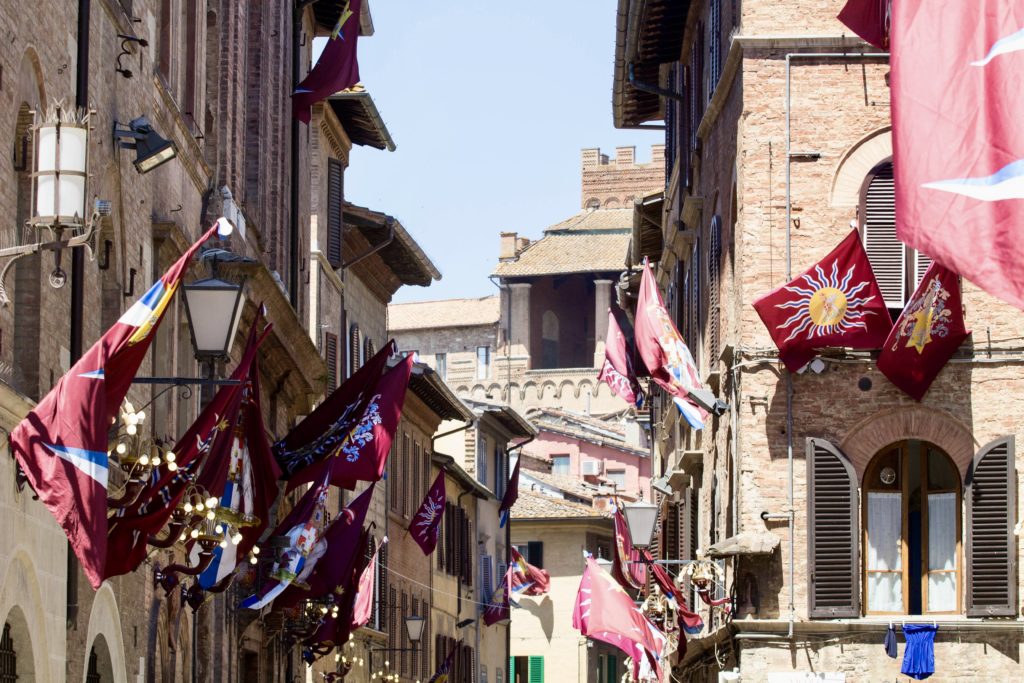
If your contrada draws a good horse, you can bribe other jockeys to secure the win and/or to block your enemy. If you draw a bad horse, your jockey’s mission is to ruin the race for the nemesis contrada.
If an ally doesn’t draw a good horse or jockey, they may try to help the sister contrada win. Or, an ally may help your contrada win if they have an enemy racing who they hope to thwart.
A jockey may even offer to throw the race to another contrada. But this tactic is high risk and may get the jockey lynched. There are stories of jockeys having a cab waiting for them to escape the ire of a contrada.
The deals continue right up to the starting line. There’s no knowing what’s been negotiated.
To try to reign in the criminality to some small degree, the jockeys are never alone. They are stalked by their designated contrada members, who try to prevent the jockeys from making deals contrary to the contrada’s interests.
There’s never been any attempt to impose any rules on the race. The Sienese like the Palio just as it is — with deception, foul play, and skullduggery as the norm.
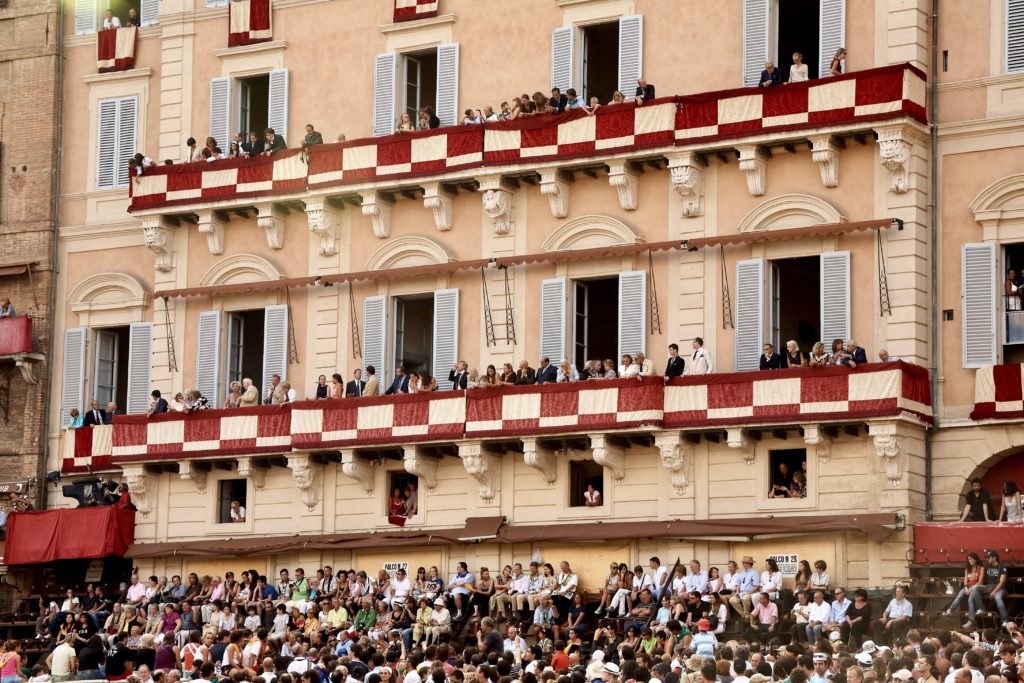
The Spectators
Virtually the entire city shows up for the race. 60,000 people are packed like sardines in the piazza when the race takes place.
There’s standing room only inside the square itself. People line up hours before to claim their prized spots.
Bleacher seats are also installed all around the piazza. They are put up for sale.
If you have the right connections, or hundreds of dollars to spend, you can also view the race from the many windows and balconies that ring the piazza and function like opera boxes.
Usually only 3-4 people can squeeze into a window though. It helps to be tall and have a high tolerance for crowds.
In the days before the race, the energy is intense. Macho males sing contrade anthems and march in the streets.
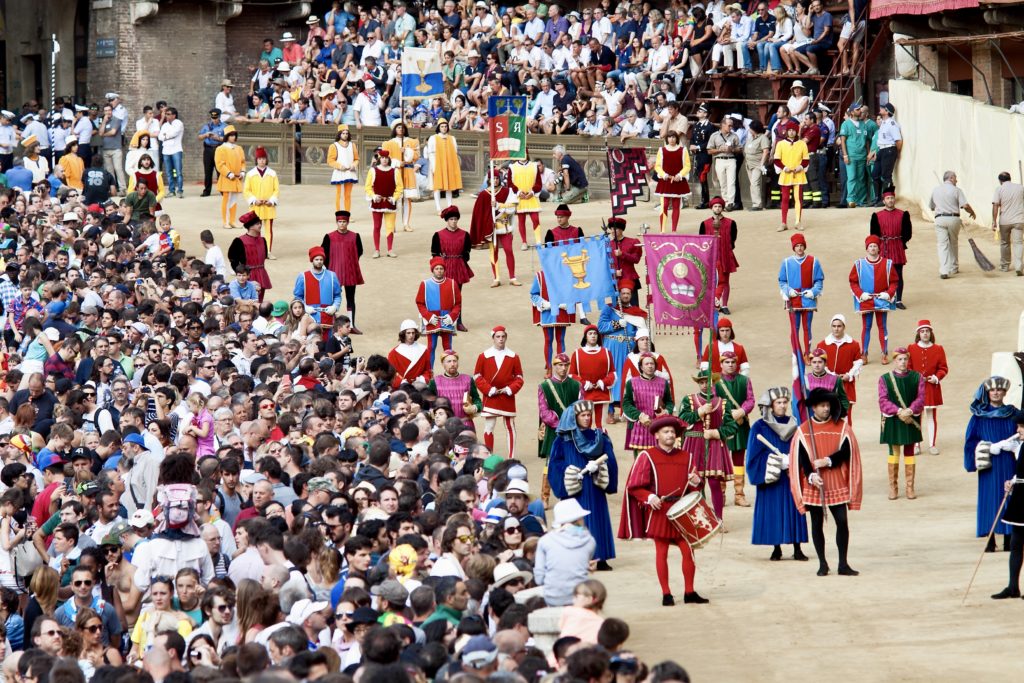
Race Day: The Palio di Siena
The Palio is kicked off with mass at the Duomo. Then, there’s a benediction ceremony for the horses.
This is followed by a choreographed two hour pageant. There are nearly 600 people in historical costume, many on horseback. All 17 contrade participate.
Members of the contrade dress in medieval costume, preceded by flag throwers, trumpeteers, and drummers. A prize is awarded to the most elegant costume. Making these elaborate costumes is another expense the contrade incur when preparing for the Palio.
Before the actual race, there have been six rehearsal races in the three days leading up to the official race.
The horses enter the square from the Palazzo Pubblico (Town Hall) at 7:00 pm on race day. At that time, they learn their starting positions, which have been drawn by lot. The inside positions are the best.
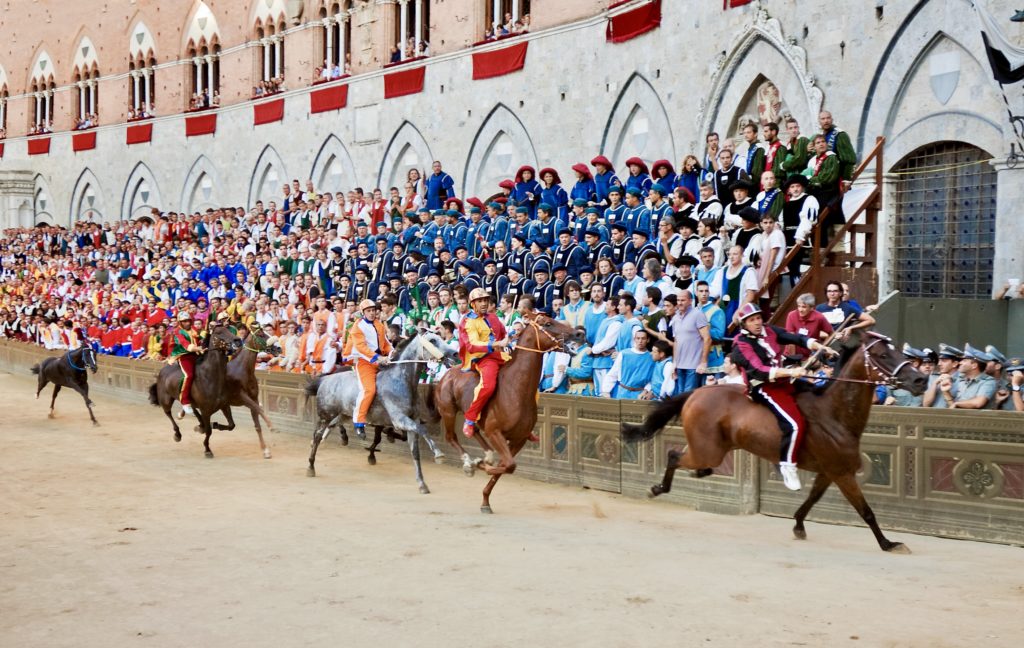
To ensure as much chaos as possible, there are no starting gates. The horses line up in a horizontal formation from 1 to 9.
You don’t want your enemy contrada next to your horse. The 10th horse doesn’t line up with the others and gets a running start.
With tension at a fever pitch, there are usually numerous false starts. During this time, the jockeys are still swapping taunts and negotiating bribes. This may go on for 30 minutes.
A judge, or master of the start, drops the rope to mark the formal beginning of the race, after trying to get the horses aligned. You don’t want to start racing at the exact time as your enemy contrada.
Then, the jockeys hurl themselves into madness. They race around the course at breakneck speed with nothing but a dried whip.
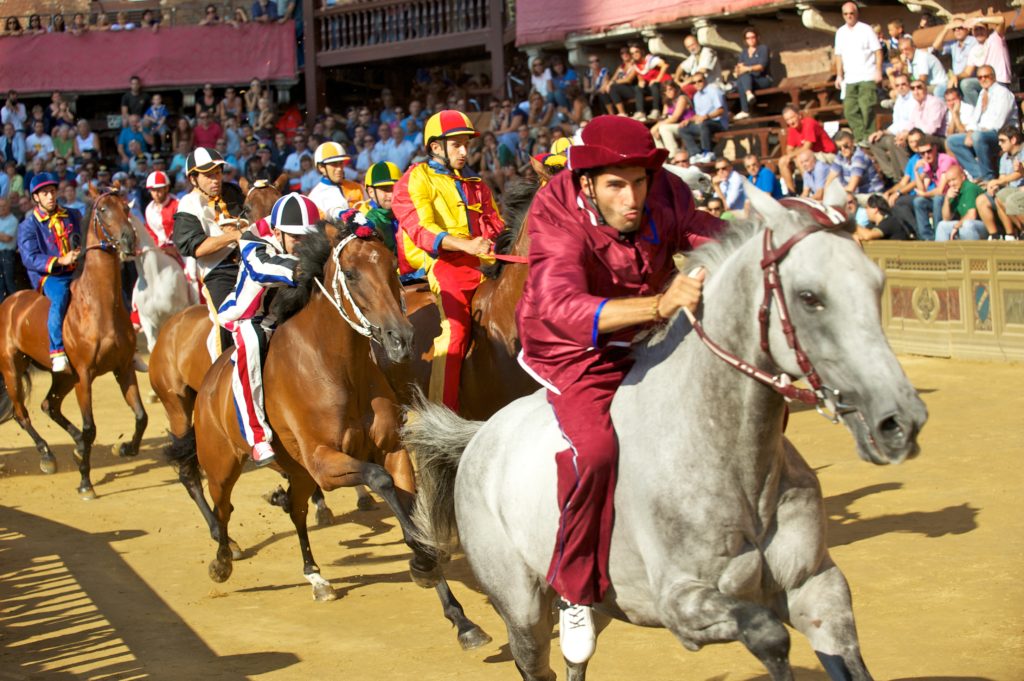
There are no racing rules. Jockeys can whip other horses and even other jockeys. The only thing they can’t do is touch the reins of another horse.
It’s pure pandemonium. People are screaming and crying.
The horses race clockwise three times around a one-third-of-a-mile track and there are tight turns. The second turn is the most dangerous. It’s a hairpin 80% turn downhill at breakneck speed.
This is where the horses might lose their jockeys. But if the jockey falls off and the horse wins, it doesn’t matter. The horse and its contrada still win, in a rare event known as cavallo scosso.
There are plenty of spills, with both jockeys and horses being injured. Lately, precautions have been taken with mattresses and padding placed around the turns.
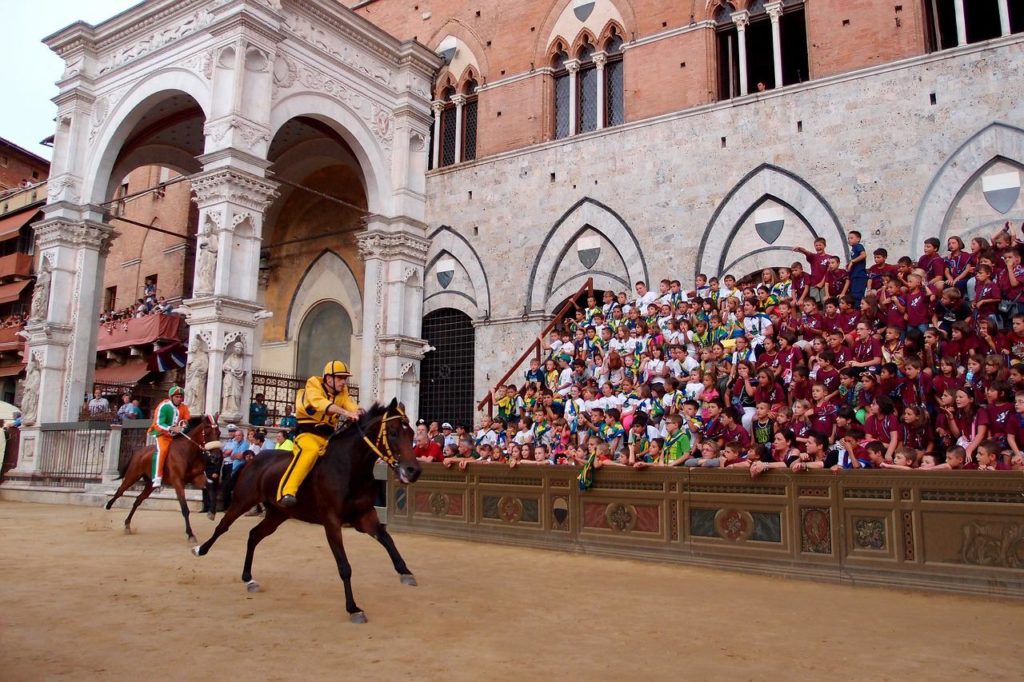
A victory is an in credibly moving emotional sight. The Palio is presented to the winning contrada. The Sienese drop to their knees in tears, overcome by the miracle of winning a Palio in their lifetime.
And it’s not just a race. The Sienese eat and drink themselves into a semi-catonic state. The excitement is unbearable and emotions run high.
At the end of the race, the whole city becomes unhinged. The winning horse is taken to Siena Cathedral to be blessed, with admirers following in tow.
Out come the pacifiers and the baby bottles filled with red wine. Some men even wear diapers.
These items are meant to symbolize rebirth. The contrada members also don their colorful contrada scarves.
Post-Race Celebrations
Huge tables are set outside for meals, which go on all night. Entire streets become outdoor restaurants.
In Siena, your identity is your contrada and you take that identity with your everywhere. If you win, you are the top dog with bragging rights.
If your enemy loses, a contrade may celebrate the fact that they didn’t win or mock them for a month.
Naturally, there is a large post-race contrada dinner. The winning horse joins the winning jockey at the head of the long dinner table with its own meal of hay.
The fun doesn’t end on the day of the race. People from the winning contrada parade around the Campo for several nights waving the Palio to celebrate and to annoy everyone else.
The celebrations go on for over 2 months. If you get tired of celebrating, you’ll be mocked by other contrade.
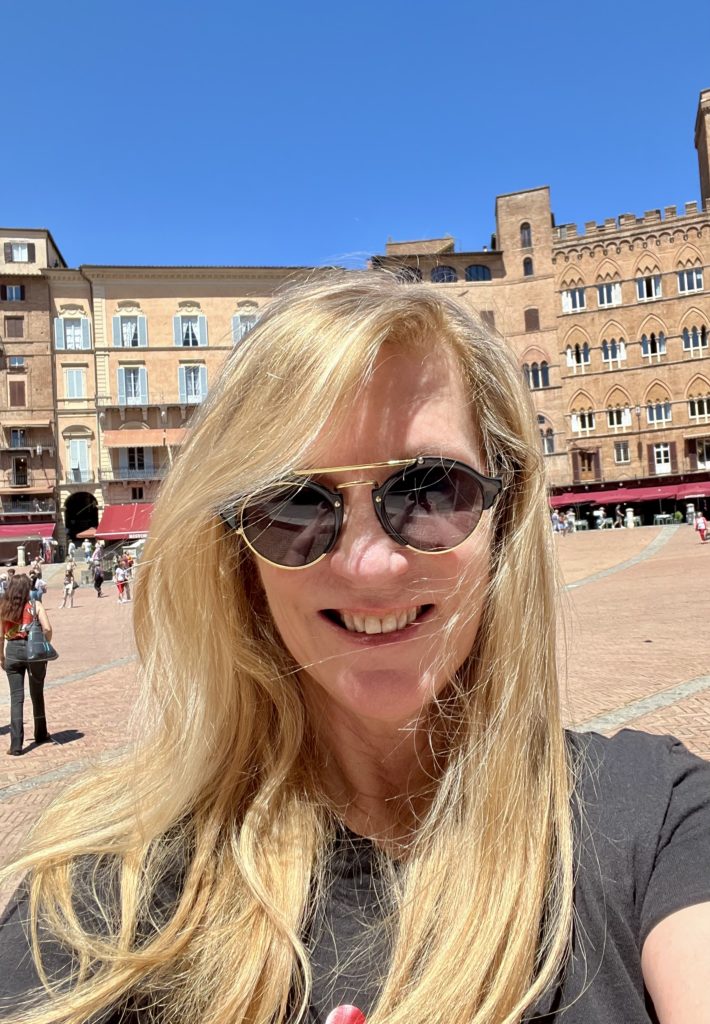
How To Attend The Palio
It’s difficult to visit an entire contrada itself. But you can book a 3 hour guided tour that includes a visit to a contrada museum. This is where the Palio banners and costumes are on display.
If you want to attend the Palio itself, you should plan to arrive in Siena several days in advance. You can enjoy the tension and excitement as the race nears.
You can also watch the rehearsal races. This is a good chance to figure out where you want to stand in the piazza. And to get some less frantic photos.
You can watch the Palio for free from the mosh pit that’s the center of the Campo. Children under 10 aren’t allowed in for safety reasons.
Or, you can book tickets for a balcony seat here. The tickets can be booked up months in advance.
It won’t be roomy. You’ll be wedged in with others. And there are no rest rooms.
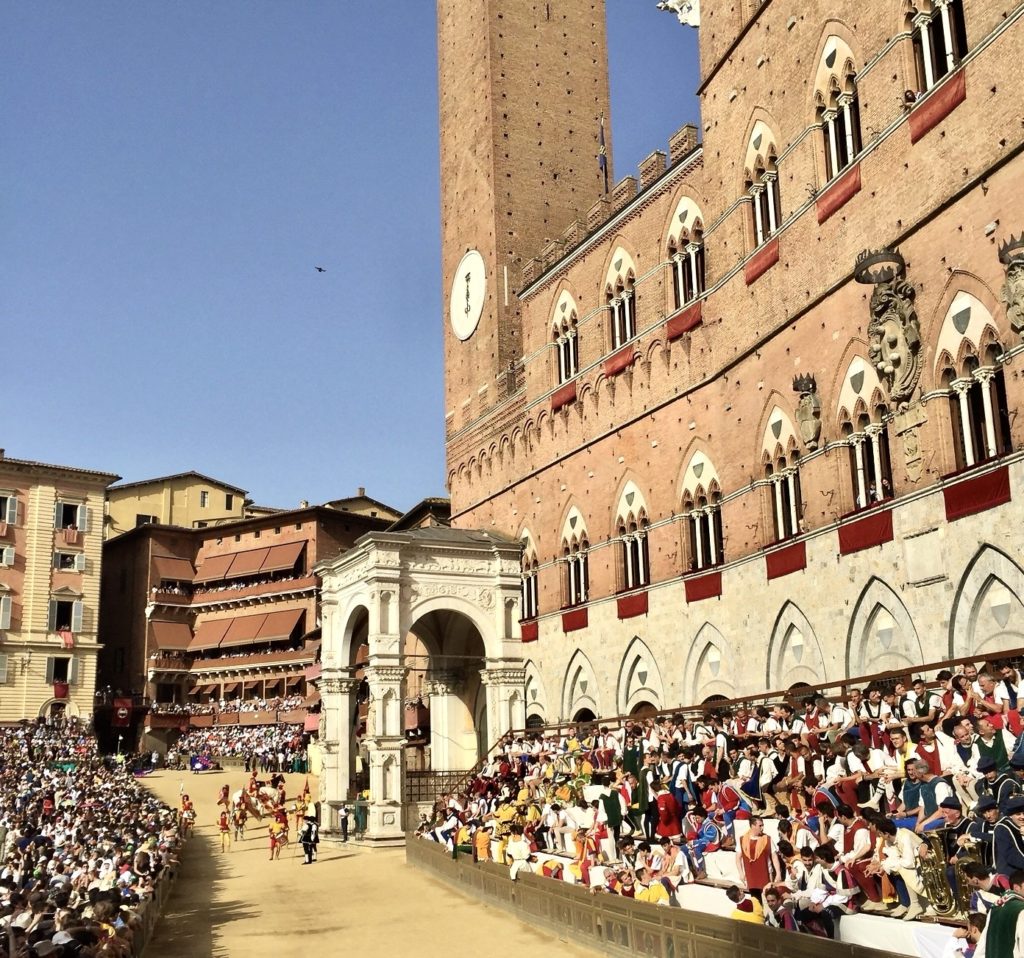
To really get in the spirit, you can even join a contrade if you pay the annual dues. Then you can dress in its colors for the race or buy the contrada scarf.
You may want to book a package tour with a company like Palio Tours. The tour company will typically give you a walking tour of Siena, arrange for you to have dinner at one of the contrade, and give you tickets for bleacher sets.
Be aware that people may book hotels for the Palio years in advance. Siena has some excellent accommodations. You can stay in luxe hotels, castles, or palazzos.
You should check out the Grand Hotel Intercontinental (vintage grandeur in a former palazzo), Hotel Certosa di Maggiano (converted 14th century monastery), or the Regio Relais (central location).
You can take a romantic mini-break in the beautiful Palazzo Ravizza. Or enjoy a boutique guest house in an unbeatable location, the Il Battistero Siena. The Relais degli Angeli is the epitome of Tuscan elegance.
I hope you’ve enjoyed my guide to the contrade and the Palio of Siena. You may enjoy these other Tuscany travel guides:
- 10 Days in Tuscany itinerary
- 1 Day In Florence Itinerary
- 3 Days in Florence Itinerary
- Best museums in Florence
- Hidden gems in Florence
- 1 Day In Siena Itinerary
- Guide To Siena Cathedral
- Best Things To Do in San Gimignano
- Best Things To Do In Montepulciano
- Best Things To Do In Pienza
Pin it for later.

